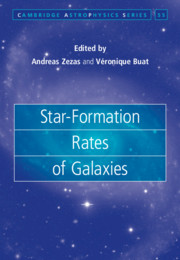Book contents
- Frontmatter
- Contents
- List of Figures
- List of Tables
- List of Contributors
- Preface
- Part I Background
- Part II SFR Measurements
- 5 Star-Formation Rates from Resolved Stellar Populations
- 6 Star-Formation Measurements in Nearby Galaxies
- 7 Continuum and Emission-Line Star-Formation Rate Indicators
- 8 Star-Formation Rates from Spectral Energy Distributions of Galaxies
- 9 Modelling the Spectral Energy Distribution of Star-Forming Galaxies with Radiative Transfer Methods
- 10 Measuring the Star-Formation Rate in Active Galactic Nuclei
- 11 High-Energy Star-Formation Rate Indicators
- Index
6 - Star-Formation Measurements in Nearby Galaxies
from Part II - SFR Measurements
Published online by Cambridge University Press: 11 May 2021
- Frontmatter
- Contents
- List of Figures
- List of Tables
- List of Contributors
- Preface
- Part I Background
- Part II SFR Measurements
- 5 Star-Formation Rates from Resolved Stellar Populations
- 6 Star-Formation Measurements in Nearby Galaxies
- 7 Continuum and Emission-Line Star-Formation Rate Indicators
- 8 Star-Formation Rates from Spectral Energy Distributions of Galaxies
- 9 Modelling the Spectral Energy Distribution of Star-Forming Galaxies with Radiative Transfer Methods
- 10 Measuring the Star-Formation Rate in Active Galactic Nuclei
- 11 High-Energy Star-Formation Rate Indicators
- Index
Summary
Recipes for the determination of SFRs of and within galaxies have enabled many advances in understanding the properties and physics of stellar and galaxy populations. However, like all recipes, they have significant limitations, and they are usually only applicable within the luminosity and physical range where they have been calibrated. Outside this range, they can under/overestimatethe true SFR up to factors of several. Recipes are based on the assumption of a constant SFR over some period of time. For practical reasons, the `mass of newly formed stars' is typically extrapolated from the sum of the mass of massive stars, and the `period of time' is the lifetime of those massive stars. These choices are dictated by purely observational constraints and the cumulative light from the massive stars is used for the purpose of measuring SFRs. Analysis of large samples of star-forming regions within galaxies can average out variations in physical properties, enabling the calibration of `local' SFR indicators. In this chapter single-band SFR indicators in the mid- and far-infrared arepresented and discussed as a function of region size. The need to account for both dust attenuated and unattenuated star formation has led to the formulation of SFR indicators that combine an optical or UV tracer with an infrared or radio tracer, both for galaxies and star–forming regions. We discuss these calibrations and the main limitations of these recipes when they are applied within galaxies.
- Type
- Chapter
- Information
- Star-Formation Rates of Galaxies , pp. 145 - 158Publisher: Cambridge University PressPrint publication year: 2021



